Dreaming of a clutter-free living room that radiates calm? Minimalist design isn't just a trend – it's a way to create a peaceful home sanctuary that's both beautiful and functional. Discover simple tips to transform your space with clean lines, strategic furniture placement, and thoughtful decor choices.
Embrace Natural Light and Space
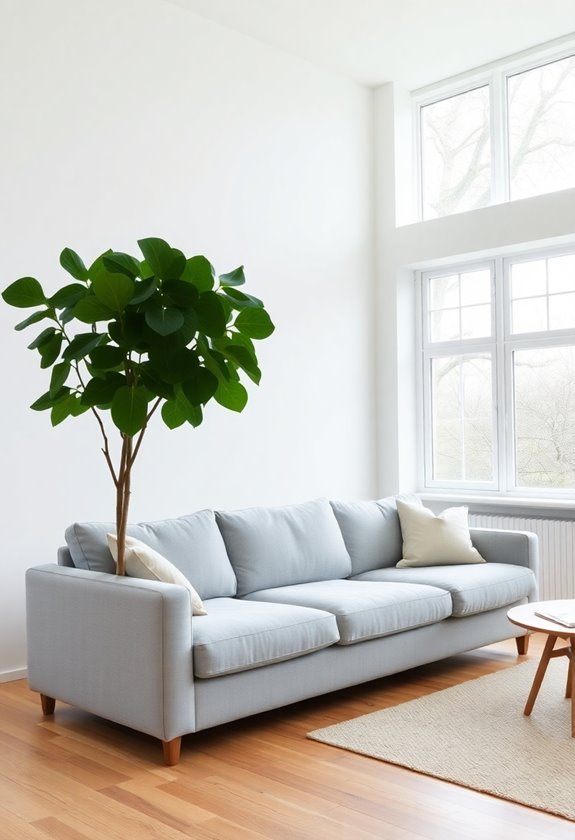
Nature's most powerful design element – natural light – stands at the heart of minimalist living room design.
You'll want to maximize its impact by installing large windows and choosing sheer curtains that filter sunlight while maintaining privacy.
Complement natural light with a neutral color scheme and reflective surfaces.
Keep your space open and uncluttered, removing unnecessary partitions to let light flow freely.
Monochromatic Color Schemes
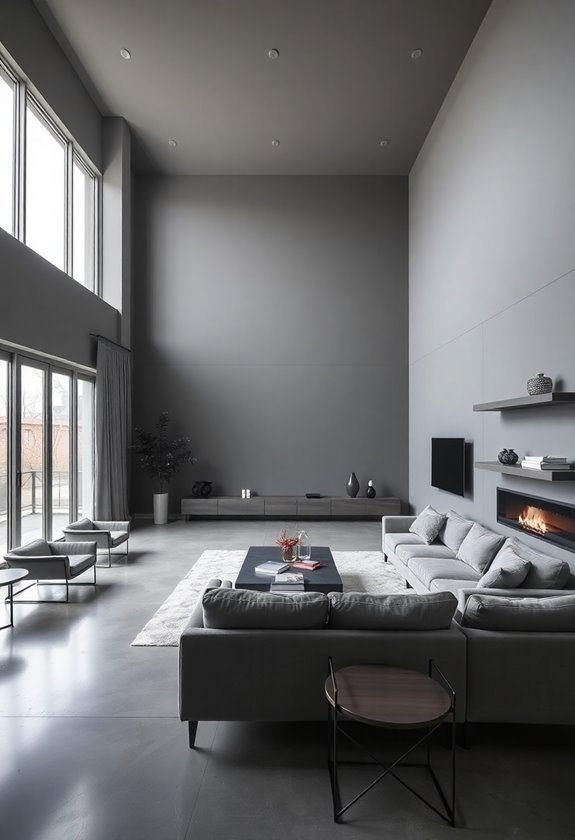
Building on the beauty of natural light, a monochromatic color scheme can further amplify your minimalist living room's sense of serenity and space.
Choose a neutral palette of whites, beiges, or grays as your foundation, then layer different shades and textures of your chosen hue.
You'll create visual interest through varied materials and finishes while maintaining the room's streamlined aesthetic.
Strategic Furniture Placement
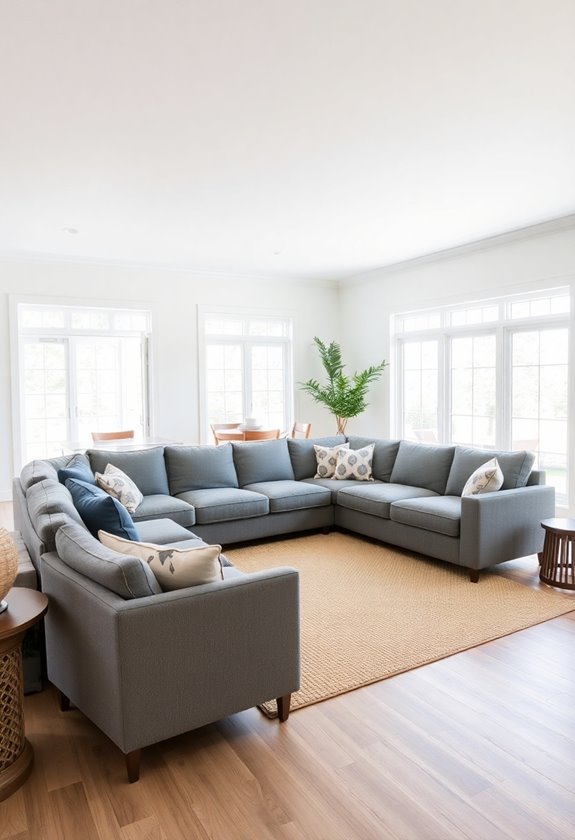
The art of furniture placement forms the backbone of any successful minimalist living room design.
Strategic furniture placement begins with positioning your larger essential pieces against walls, creating open pathways for easy movement.
You'll want to define spaces using area rugs and embrace symmetry with matching elements.
Consider multifunctional furniture to maximize utility while maintaining a clean, uncluttered aesthetic.
Anchor your seating arrangement with a minimalist area rug to create a cohesive, sophisticated look that ties the room together.
Modern Storage Solutions
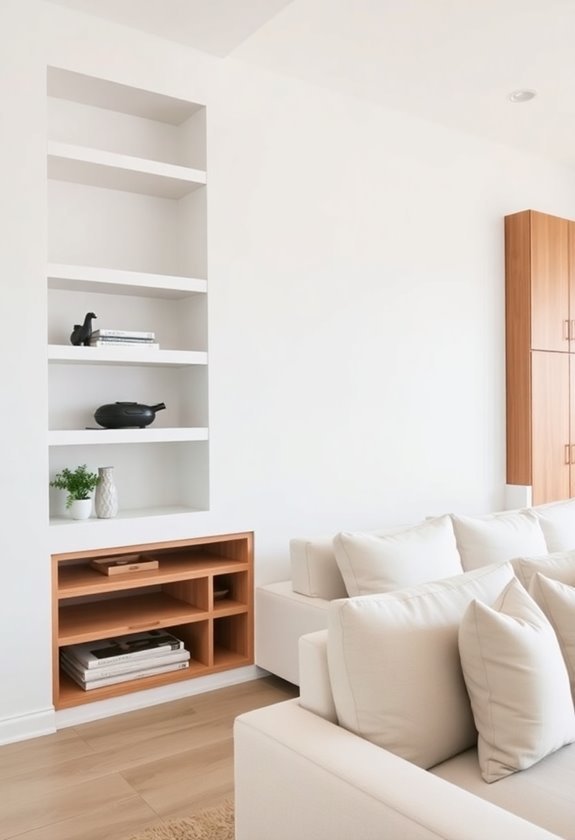
Modern storage solutions serve as the cornerstone of successful minimalist living rooms, where every element must earn its place through both form and function.
You'll maximize your space by incorporating hidden storage within ottomans and coffee tables, while multi-functional furniture keeps your room versatile.
Built-in shelving creates organized vertical storage, and floating cabinets maintain an open feel while concealing everyday items.
Layered Textures and Materials
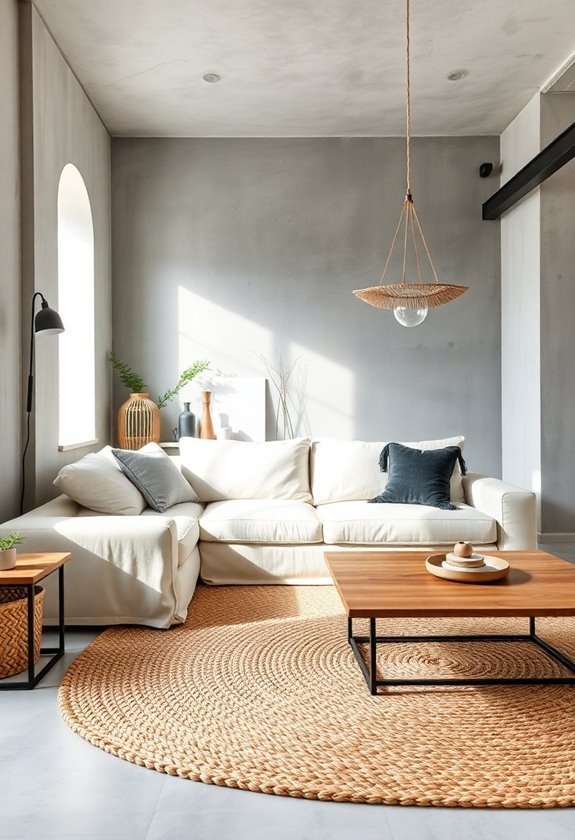
Masterful texture layering transforms minimalist living rooms from stark spaces into inviting sanctuaries.
You'll create depth by combining soft fabrics like velvet and linen with natural materials such as wood and stone.
Layer plush throws and cotton cushions against sleek metal surfaces, while mixing light oak and walnut finishes maintains the minimalist aesthetic.
An oversized rug unifies these layered textures perfectly.
Elegant ceramic vase displays can introduce subtle textural elements while maintaining clean lines.
Complete the refined look with side table decor that incorporates mixed materials and organic elements.
Statement Art Pieces
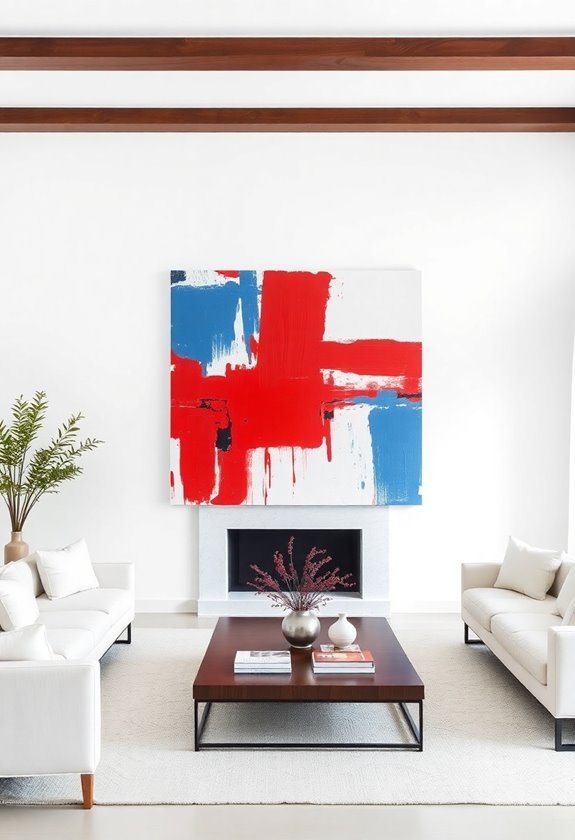
Impact resonates powerfully through statement art pieces in minimalist living rooms.
By selecting large-scale artwork as your focal point, you'll create dramatic visual interest while maintaining clean aesthetics.
Position oversized canvases or photographs at eye level to enhance your room's flow.
You can express your personality through bold colors and striking patterns while staying true to minimalist principles of intentional simplicity.
Clean Lines and Geometry
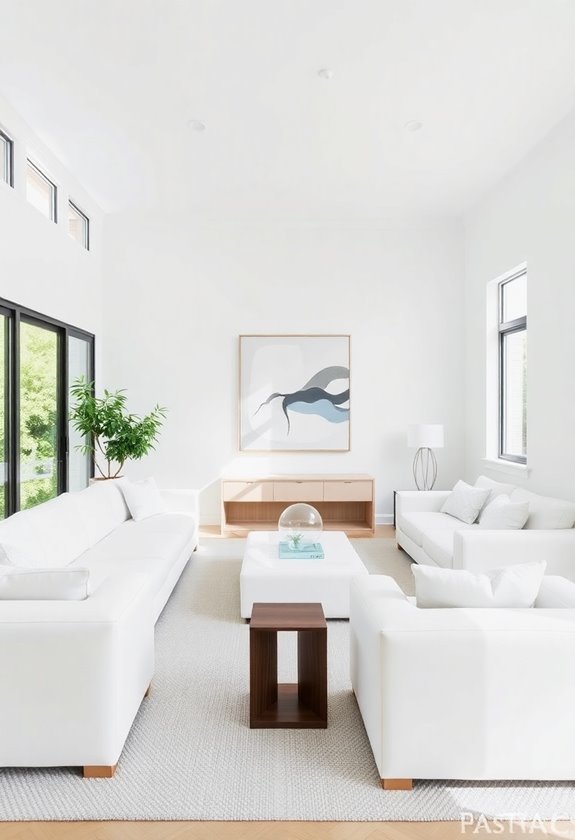
Beyond bold artwork, the foundation of minimalist design rests in clean lines and precise geometric forms.
You'll find these elements in low-profile furniture with straight edges and angular silhouettes.
In minimalist interiors, incorporate geometric shapes through subtle patterns in rugs or wall decor.
Arrange your furniture symmetrically or asymmetrically, and add floating shelves to maintain an uncluttered, harmonious space.
Indoor Plants and Greenery
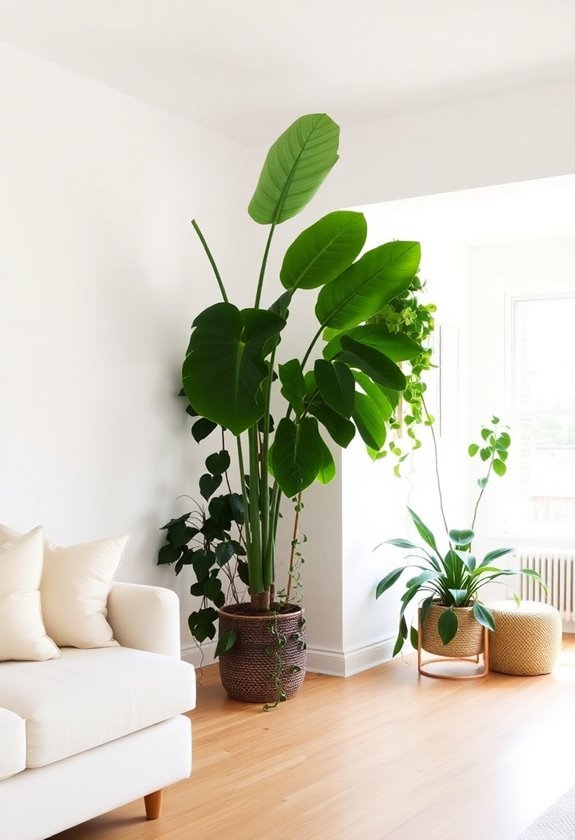
Nature's calming presence takes center stage in minimalist living rooms through carefully chosen indoor plants and greenery.
You'll find that strategically placed plants near windows not only thrive but also purify your air.
Create visual interest by combining different heights and textures of low-maintenance varieties like snake plants and pothos.
Keep your neutral space balanced with simple, understated pots that let the greenery shine.
Minimalist Window Treatments
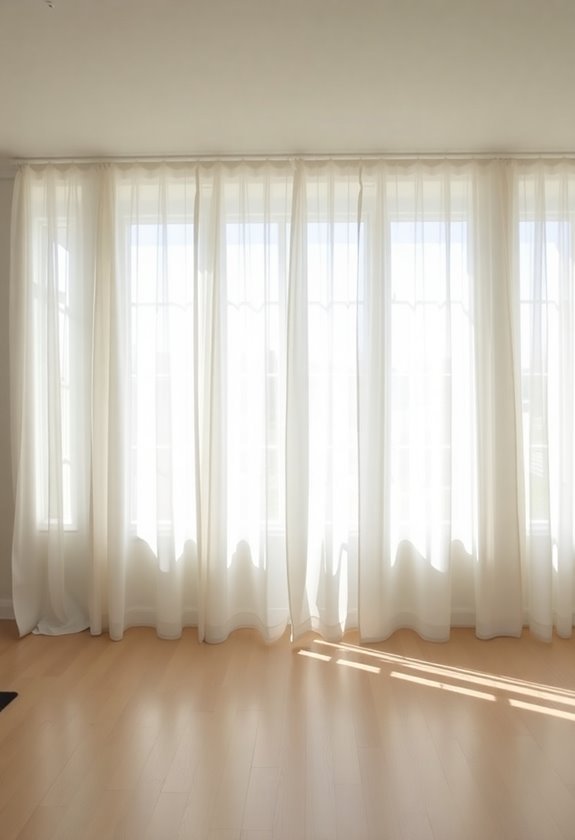
While plants bring life to your minimalist space, thoughtful window treatments set the foundation for a serene atmosphere.
In your minimalist living room, opt for sheer curtains that welcome natural light while maintaining privacy.
Consider floor-to-ceiling drapes in light fabrics or simple roller shades in neutral tones.
For a modern touch, try window film or frosted glass treatments that keep the space bright and uncluttered.
Neutral Color Palettes
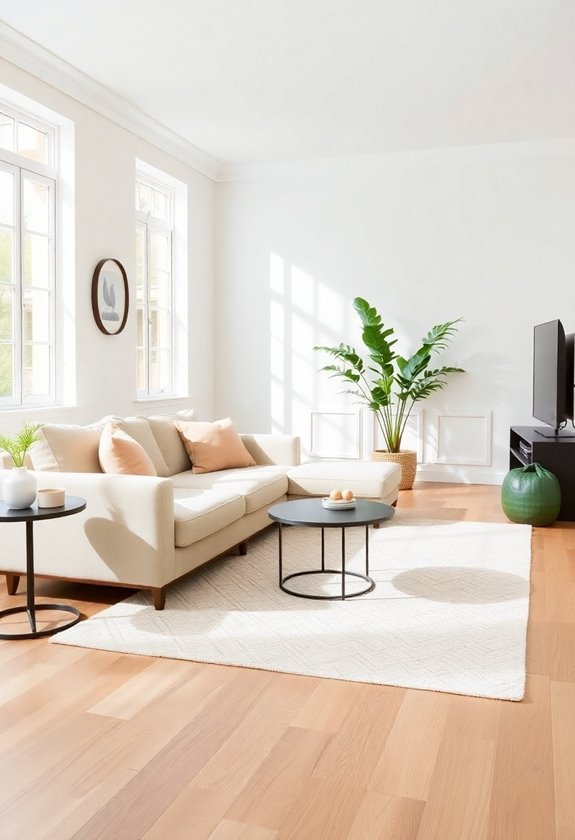
A neutral color palette sets the stage for a truly minimalist living room, creating a sense of calm and visual harmony.
You'll find that combining soft color accents like pale pink or muted blues with neutral color palettes enhances tranquility without overwhelming your space.
Consider monochromatic schemes to make your room appear larger, and layer textured materials like linen and wool for added depth while maintaining simplicity.
Multi-functional Furniture Designs
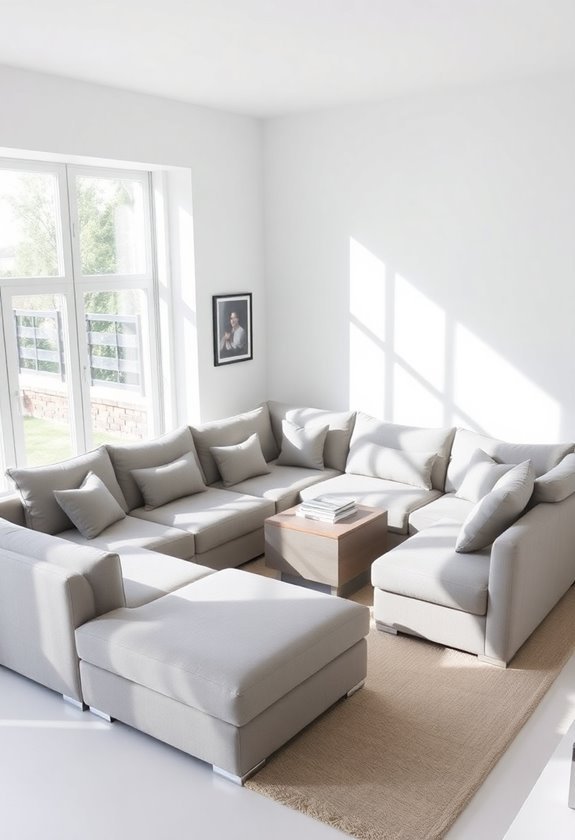
Building on the serene foundation of neutral colors, smart furniture choices become your next step toward minimalist perfection.
Embrace multi-functional furniture designs that work twice as hard in your space. Consider convertible sofas, storage ottomans, and lift-top coffee tables.
For compact living areas, opt for wall-mounted desks and modular sets that adapt to your needs while providing clever storage solutions.
Balance and Symmetry
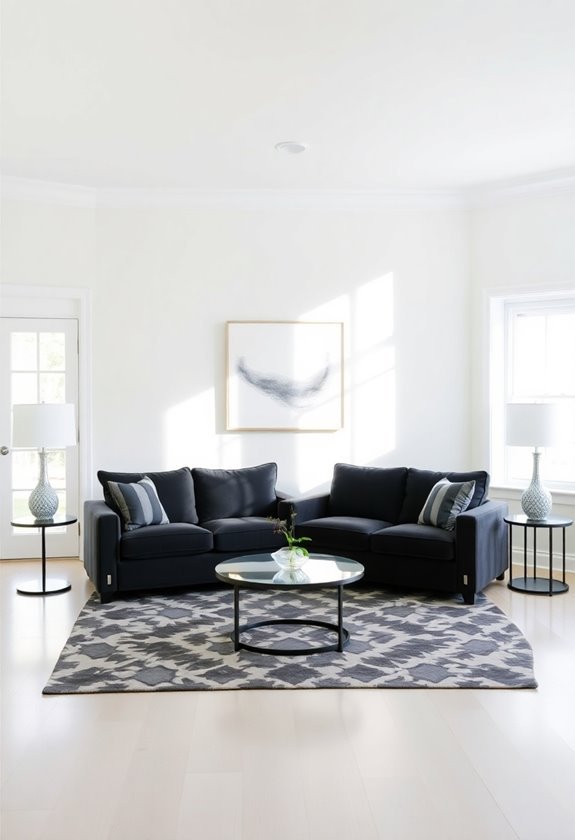
Every minimalist living room thrives on the delicate interplay of balance and symmetry.
You'll create visual equilibrium by distributing furniture evenly throughout your space and using matching pieces like identical sofas or lamps.
Consider pairing large elements with smaller ones, and use area rugs to define zones.
Don't forget to reinforce symmetry with strategically placed artwork on either side of focal points.
Complete the harmonious design by incorporating a stylish console table that anchors your wall decor while maintaining clean lines.
Focal Point Creation
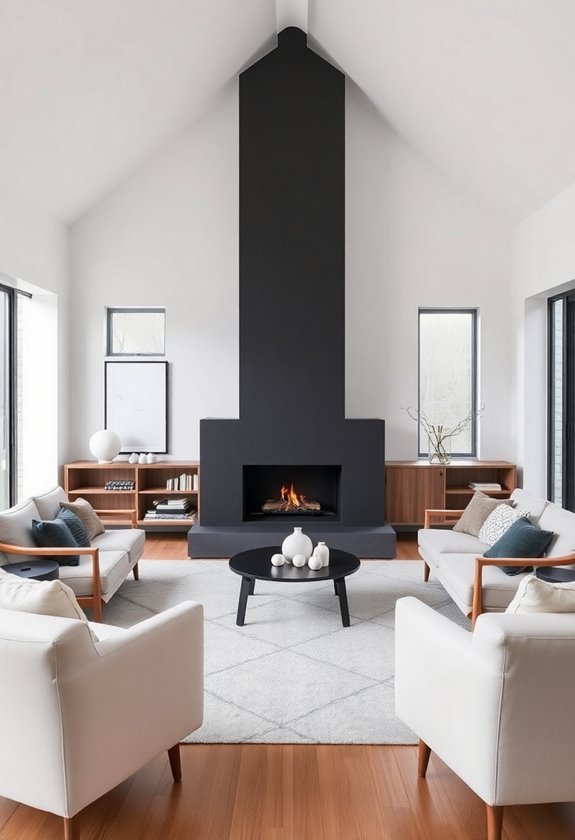
Creating a powerful focal point serves as the cornerstone of minimalist living room design.
You'll find that an oversized piece of art or striking furniture can make your space feel cozy without cluttering it.
Consider using a large mirror to reflect light and create depth, or incorporate a bold statement piece in a vibrant color.
Position your focal point strategically to guide the eye and enhance your minimalist decor.
Organic Shapes and Forms
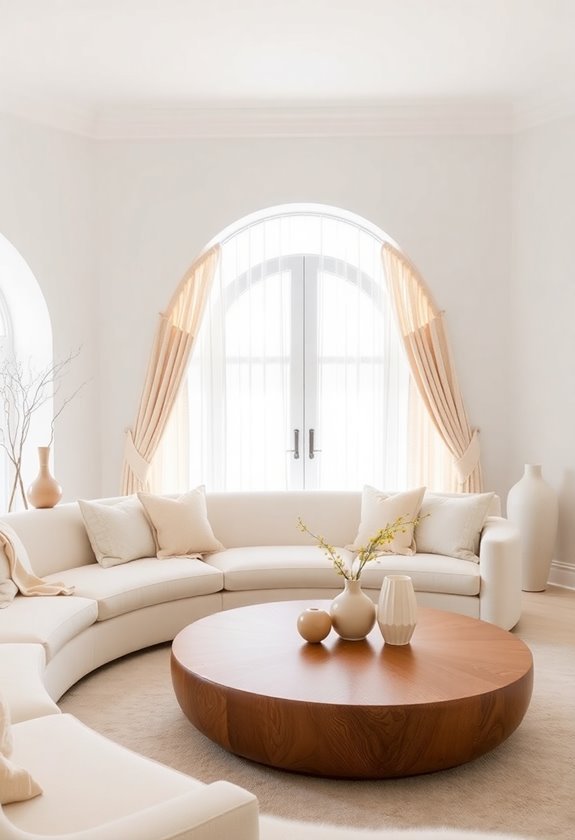
Nature's flowing curves and organic shapes bring essential warmth to minimalist spaces.
You'll find that curved sofas and rounded coffee tables create a welcoming atmosphere while maintaining clean aesthetics.
Incorporate natural textures through woven rugs and smooth wooden furniture to enhance the organic feel.
Add sculptural elements like arched lamps and flowing chairs to achieve perfect balance in your minimalist design.
Hidden Storage Elements
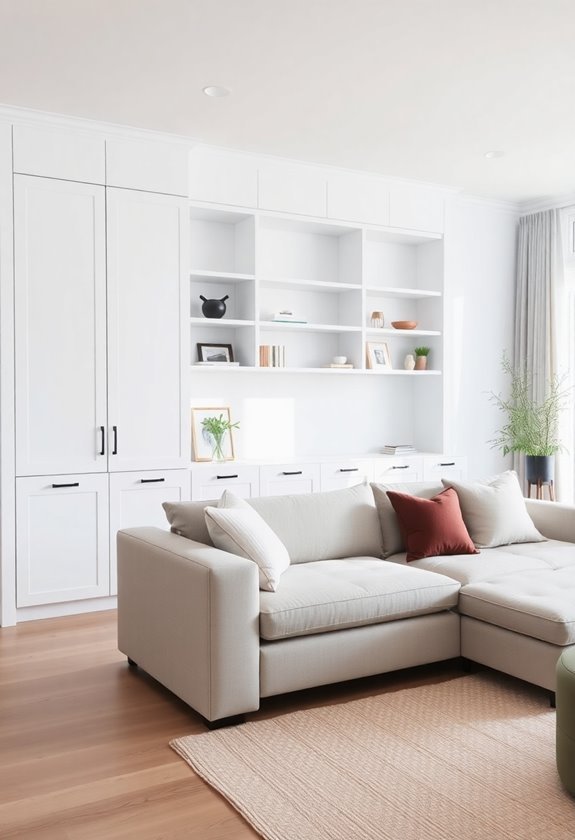
While organic shapes bring beauty to minimalist spaces, smart storage keeps them clutter-free and functional.
You'll find hidden storage solutions seamlessly integrated through built-in cabinetry and under-seat compartments.
Multi-functional furniture, like storage ottomans and lift-top coffee tables, doubles as both decor and organization.
Vertical storage options, including floating shelves and tall bookcases, maximize wall space while maintaining your room's open feel.
Lighting as Design Elements
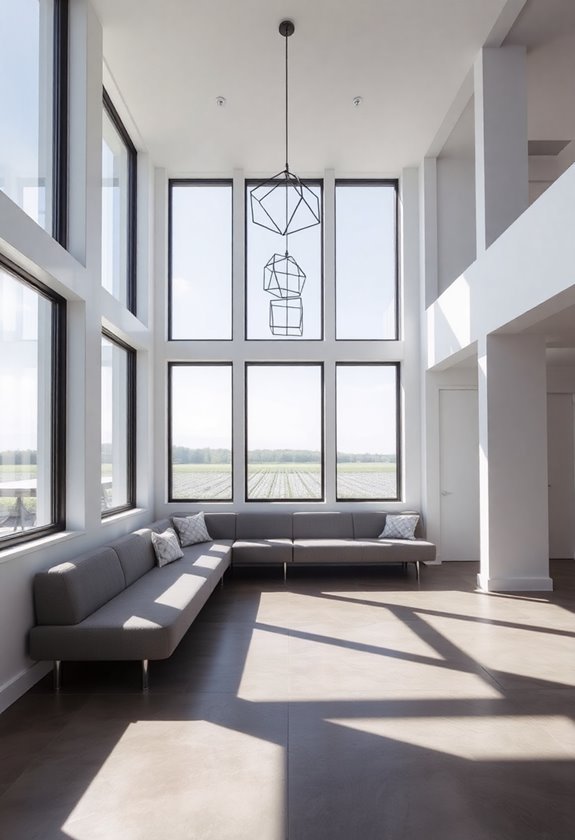
Light serves as a powerful design element in minimalist spaces, transforming bare spaces into sophisticated sanctuaries.
You'll want to layer your lighting with ambient fixtures and focused task lighting to create depth without visual clutter.
Consider adding statement light fixtures, like modern chandeliers, to serve as artistic focal points.
Translucent curtains and reflective surfaces will amplify natural light, enhancing your room's minimalist charm.
For an authentic industrial touch, industrial ceiling lights can add raw character while maintaining clean lines and simplicity.
Coastal style lamps bring a relaxed, beachy elegance while maintaining the clean aesthetic of minimalist design.
Open Floor Planning
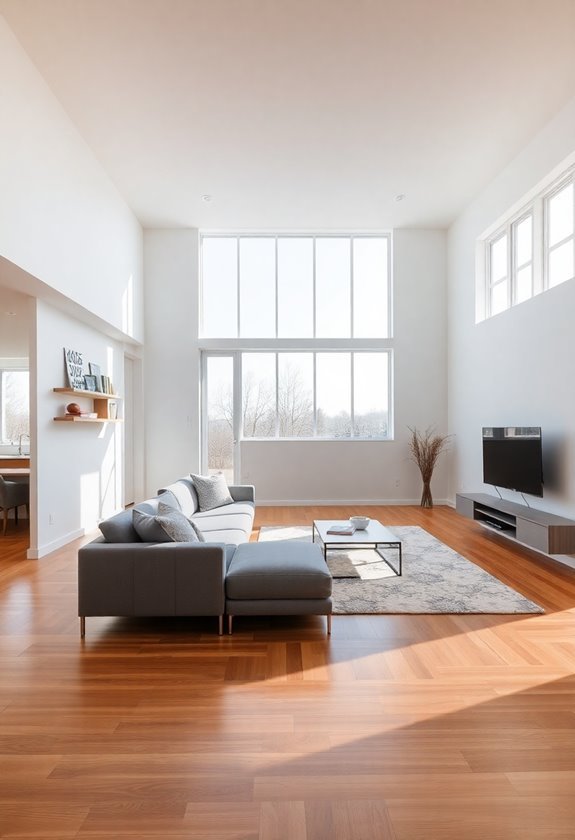
Through the art of open floor planning, your minimalist living room becomes a fluid, interconnected space that breathes life into modern living.
Create clear pathways that seamlessly connect your living areas while using multi-functional furniture to define distinct zones.
You'll maximize natural light flow and spatial efficiency by eliminating unnecessary walls, making your space feel larger and more inviting.
Floating Furniture Arrangements
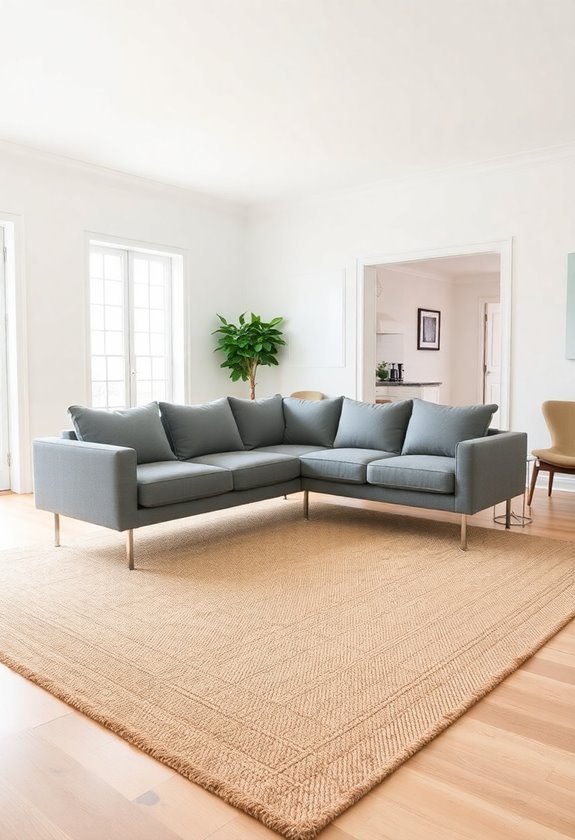
Breaking away from traditional wall-hugging layouts, floating furniture arrangements create dynamic focal points that transform your minimalist living room into an engaging conversation space.
By placing low-profile pieces away from walls on a neutral foundation of area rugs, you'll enhance space efficiency while maintaining clear sightlines.
Add multifunctional ottomans and benches to maximize flexibility and define your floating zones.
Raw Material Integration
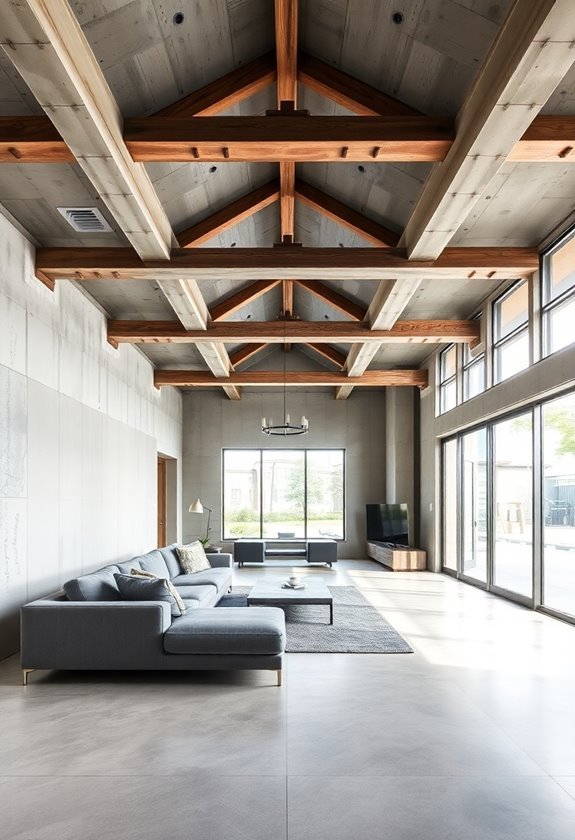
Raw materials bring soul to minimalist spaces, transforming sterile environments into inviting sanctuaries.
You'll find warmth by incorporating exposed wood beams, natural stone, and raw-edged wood slabs as statement pieces. Untreated wood furniture creates striking contrasts with modern elements, while natural fibers like jute and linen add softness.
Complete your space with ceramic vases and metal sculptures for organic visual interest.
Sculptural Accent Pieces
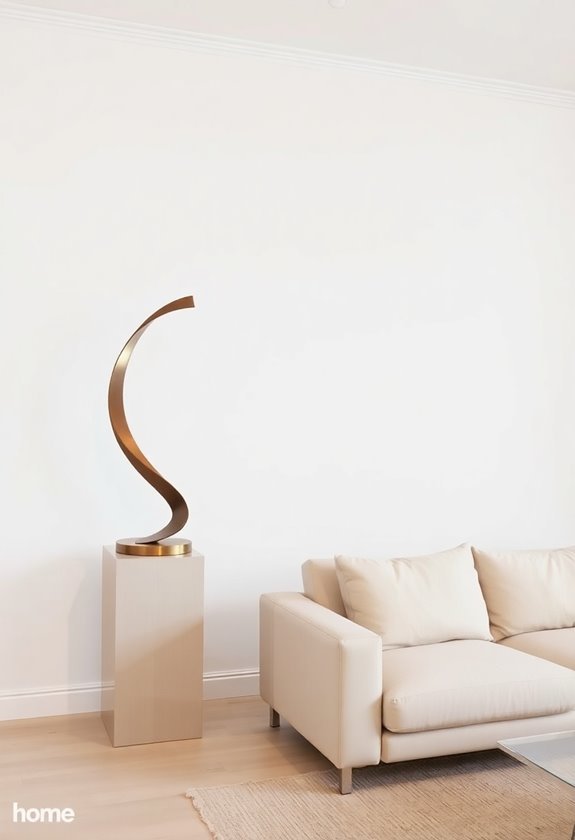
Striking sculptural pieces serve as the perfect counterpoint to minimalist design, acting as intentional statements in your carefully curated space.
When selecting sculptural accent pieces, opt for items with clean lines and organic shapes that create visual interest without overwhelming your room.
Choose one or two bold pieces crafted from natural materials like wood or stone to define your space while maintaining minimalist harmony.
Negative Space Utilization
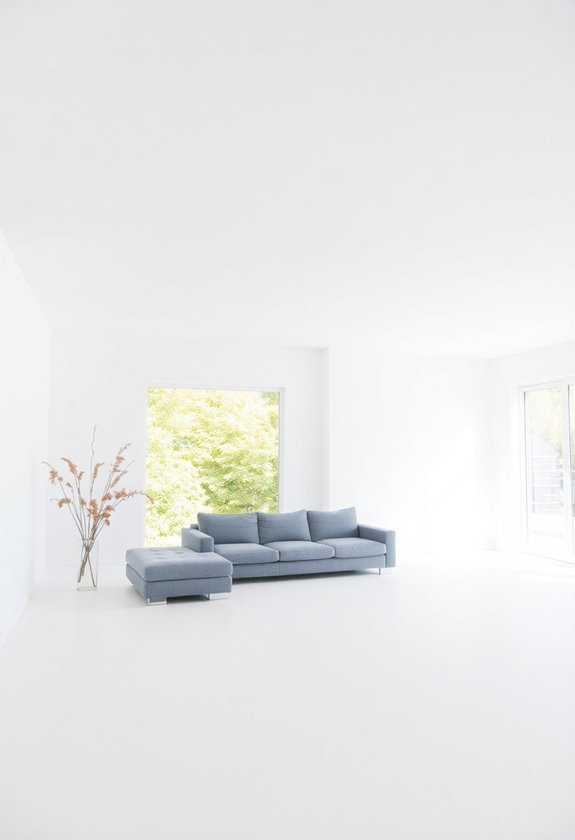
Mastering negative space is essential to achieving true minimalist harmony in your living room.
You'll create a more impactful design by strategically leaving empty areas between furniture pieces and along walls. This thoughtful approach to negative space not only emphasizes your carefully chosen decor but also promotes an uncluttered environment.
You'll enjoy enhanced functionality as clear pathways invite easy movement throughout the space.
Seamless Indoor-Outdoor Transitions
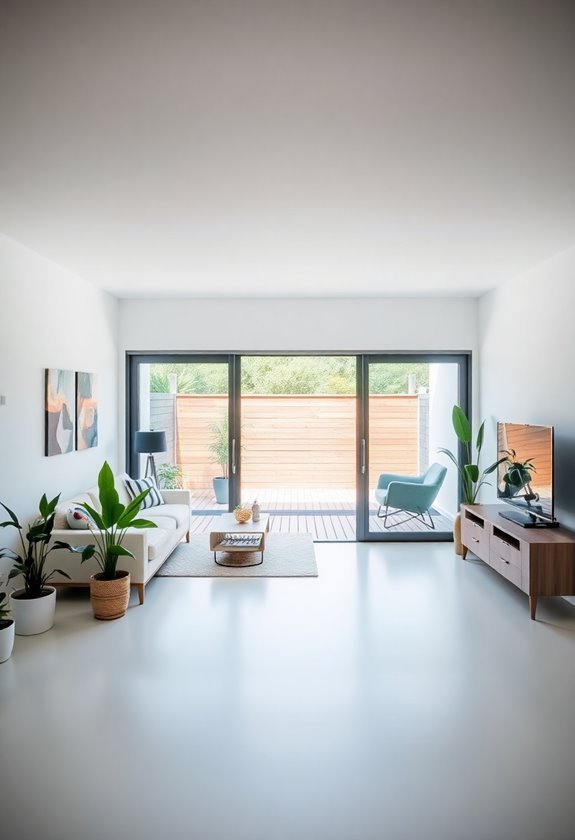
Today's minimalist living rooms embrace the art of blending interior and exterior spaces into one cohesive environment.
You'll achieve seamless changes by installing large glass doors and maintaining a neutral color palette throughout both areas.
Select matching flooring materials and mirror your indoor furniture choices outside.
Position potted plants strategically near entryways to create natural flow between indoor-outdoor spaces.
Frequently Asked Questions
How to Make Your Living Room Look Minimalist?
To make your living room look minimalist, you'll want to start by decluttering and keeping only essential items.
Choose furniture with clean lines and stick to a neutral color scheme. You can add depth with different textures rather than patterns.
Don't overcrowd your walls – select one or two meaningful pieces of art.
Maximize natural light and incorporate hidden storage solutions to maintain the clean, uncluttered look.
What Is the Best Color for a Minimalist House?
Did you know that studies show 85% of people feel more relaxed in spaces with neutral colors?
For your minimalist house, you'll want to start with a crisp white or warm beige as your primary color. You can't go wrong with a monochromatic scheme using different shades of the same neutral tone.
Add depth with subtle accent colors like soft grays or muted earth tones, but keep it simple – that's the key to minimalist perfection.
How Do I Make My House Look Minimalist?
To make your house look minimalist, you'll want to start by decluttering and removing unnecessary items.
Choose a neutral color palette with whites and beiges, and invest in multifunctional furniture with clean lines.
Keep decorations minimal, focusing on a few statement pieces.
You should incorporate smart storage solutions to hide everyday items, and maintain clear surfaces.
Remember to embrace negative space and let your rooms breathe.
How Do I Turn My Room Into a Minimalist Room?
Transform your room into a peaceful sanctuary by stripping away the noise of excess belongings.
Start with a deep declutter – if you haven't used it in six months, let it go.
Choose a light, neutral color scheme and stick to it.
You'll want to invest in dual-purpose furniture that includes storage options, and keep decorations minimal – one striking art piece is worth ten small trinkets.


